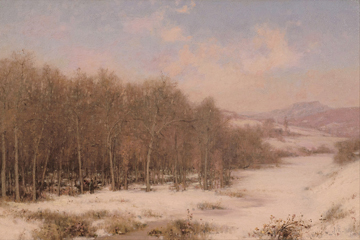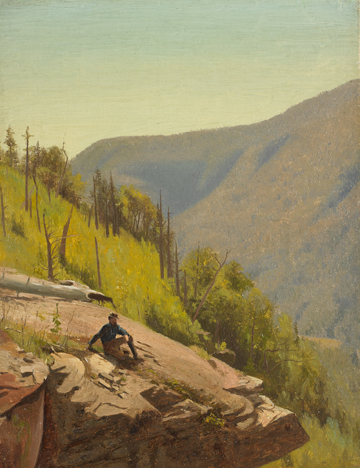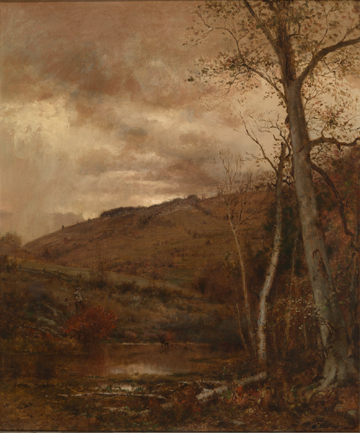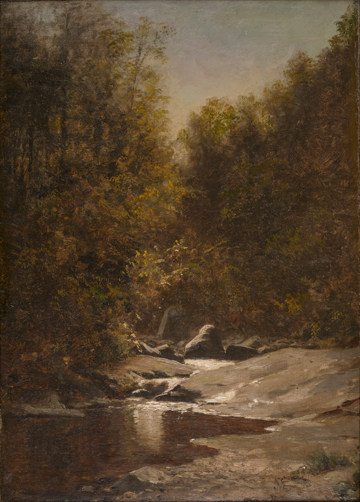Art Review: Jervis McEntee at the Samuel Dorsky Museum of Art
By Raymond J. Steiner
ART TIMES online October 2015
 “Vermont Sugaring”, c. 1874 Oil on canvas Hawthorne Fine Art, LLC, New York |
A trip into the past. To a time when artistic inspiration created beauty instead of political and social agendas, personal angst, or simply meaningless lines, shapes and colors. To a time when the soul could breathe in sublimity instead of constantly having to ward off nonsense and ugliness. To a time, alas, all too lost. Ambling amongst the landscapes of Jervis McEntee at the Samuel Dorsky Museum’s* major exhibition of this long-gone Hudson River “School” plein-airiste can almost make one feel that the past 100 years or so has simply disappeared into a black hole of much-desired forgetfulness. Curated by Lee Vedder and assisted by many helping-hands and lender/contributors, the Exhibition, “Jervis McEntee: Painter – Poet of the Hudson River School”, is comprised of approximately 75 sketches, drawings & paintings tastefully spaced, hung, or displayed throughout several ‘galleries’ of the Dorsky Museum.
 “Summer Hills”, Kauterskill Clove, 1867 Oil on canvas laid down on board . Collection of the Birmingham Museum of Art; Museum purchase with funds provided by the Friends of American Art |
Although McEntee and his fellow landscape artists often sketched and/or painted side-by-side in the Catskill and Adirondack Mountains, even ‘taking lessons’ from one another (McEntee studied for a time with Frederic Edwin Church in New York City, for example) and traveling to Europe jointly during their long-time inter-relationships, the perception that they comprised a “School”, even dubbed as members of a “Hudson River school”, was first used derisively by NYC studio artists to 'rag' on their fellows who trekked upstate to tramp through the woods and only so designated as a bona fide "School" much later by over-effusive artwriters that admired the ‘body’ of work these fellows produced and thought it would give them ‘standing’ in the artworld. I use "fellows" here somewhat reservedly, since although there have been a great many women artists in more recent years that have adopted and even deepened the aesthetic sensibilities of the "Hudson River School", I have never heard or read of any women that did so "back in the day" — however, I stand ready and willing to be informed otherwise. In any event, if one could claim any ‘schooling’ at all, it would have been by European plein-airistes whose growing fame was influencing American landscapists that were bringing back their ideas from their studying and traveling abroad. William Merritt Chase on Long Island in Shinnecock, in fact, founded the first actual plein air 'school' in America, undoubtedly influenced by his time at the Munich Academy that had its own "Woodstock" in the nearby town ("municipality") of Polling, Germany, with the Alps rather than the Catskills as a backdrop. Along with the growing interest in painting on site outside of the studio, came the romanticism fostered by those writers in England such as critics like John Ruskin or poets like Wordsworth and painters like the "Brotherhood of Pre-Raphaelities" and their creed of "Truth to Nature" — incidentally, calling the Hudson River/Catskill artists a "brotherhood" would be far more apt than decreeing them a "School" — and, in Germany, painters like Caspar David Friedrich and his fellow romanticists, the 'Nazarenes', who found their inspiration by following the "finger of God" in Nature and who came before the impact of the French Impressionists.
 “Fickle Skies of Autumn”, c. 1888 Oil on canvas The Century Association, New York |
As this show makes abundantly clear, Jervis McEntee was inspired by Nature; both European and English aesthetes taught "what God had made beautiful, ought not be made ugly" and a great many landscapists both here and abroad took the lesson to heart. While McEntee and his fellow landscapists evidently imbibed the love and inspiration that their European predecessors had for Nature, it is a bit less clear that they were more often than not concentrated on a European Nature rather than an American one. As any traveler knows, European countries (and countrysides) have been inhabited by humans and have felt their impact for centuries; by comparison, again as any traveler knows, our landscape is considerably ‘wilder’, untamed, even in much of Catskill landscape, downright “unkempt”.
Of course, there are extremes in both countries, but it would take a good many years and much labor to transform the woodland surrounding my home in High Woods, New York to resemble one-one thousandth the amount of manicured gardens of, say, Versailles. Even my strolls through Germany’s Black Forest were not as hampered by fallen branches or bushes as I've found it to be, trying to venture even a few steps outside behind my study. The decayed debris found in most American ‘woods’ simply doesn’t exist in the nearby woods in Europe where villagers have been scouring for firewood since God invented winter. Once you step out of town, most of the landscape of the Hudson Valley is still unkempt. McEntee and his “school” mates often depict this wildness, but even more often depict their forefront focal points as oddly ‘neatened’ up.
 “View Near Kingston, NY”, n.d. Oil on canvas Private Collection |
Almost as if they chose a spot and, armed with rakes and baskets, cleaned the place up so that their posed figures would not be too uncomfortable. Then, in the surrounding mid- and backgrounds, their hands loosen up and brushstrokes become a bit less fussy. Nothing sublime about a Nature that repels you from getting too close, after all. There are times, however, when ‘wild and messy’ is sublime in an awesome way: a cloud strewn sky at sunset, for instance — and most of the Hudson River/Catskill Mountain painters knew when to let Nature have its own way. Whatever your own predilections, a slow, quiet stroll through McEntee’s vision of Nature is certainly a true breath of fresh air. Kudos to Lee Vedder and all the others who made this exhibition at the Dorsky Museum a reality for all to enjoy. Go treat yourself!
* “Jervis McEntee: Painter – Poet of the Hudson River School”: Samuel Dorsky Museum of Art, SUNY New Paltz, NY, 845-257-3844 (thru Dec 13). newpaltz.edu\ museum\
A concurrent McEntee exhibition, "Jervis McEntee: Kingston's Artist of the Hudson River School" is on view at The Friends of Historic Kingston, Corner of Main & Wall Streets, Kingston, NY 845-339-0720 (thru Dec 31). fohk.org.
(Editor's note: It is a welcome occurrence that two such McEntee exhibitions are currently on view; for far too long, Jervis McEntee, a native son born in the heart of the Hudson River/Catskills in Rondout (Kingston) New York, has been somewhat of a forgotten member of the Hudson River / Catskill Mountain group of landscapists.)
